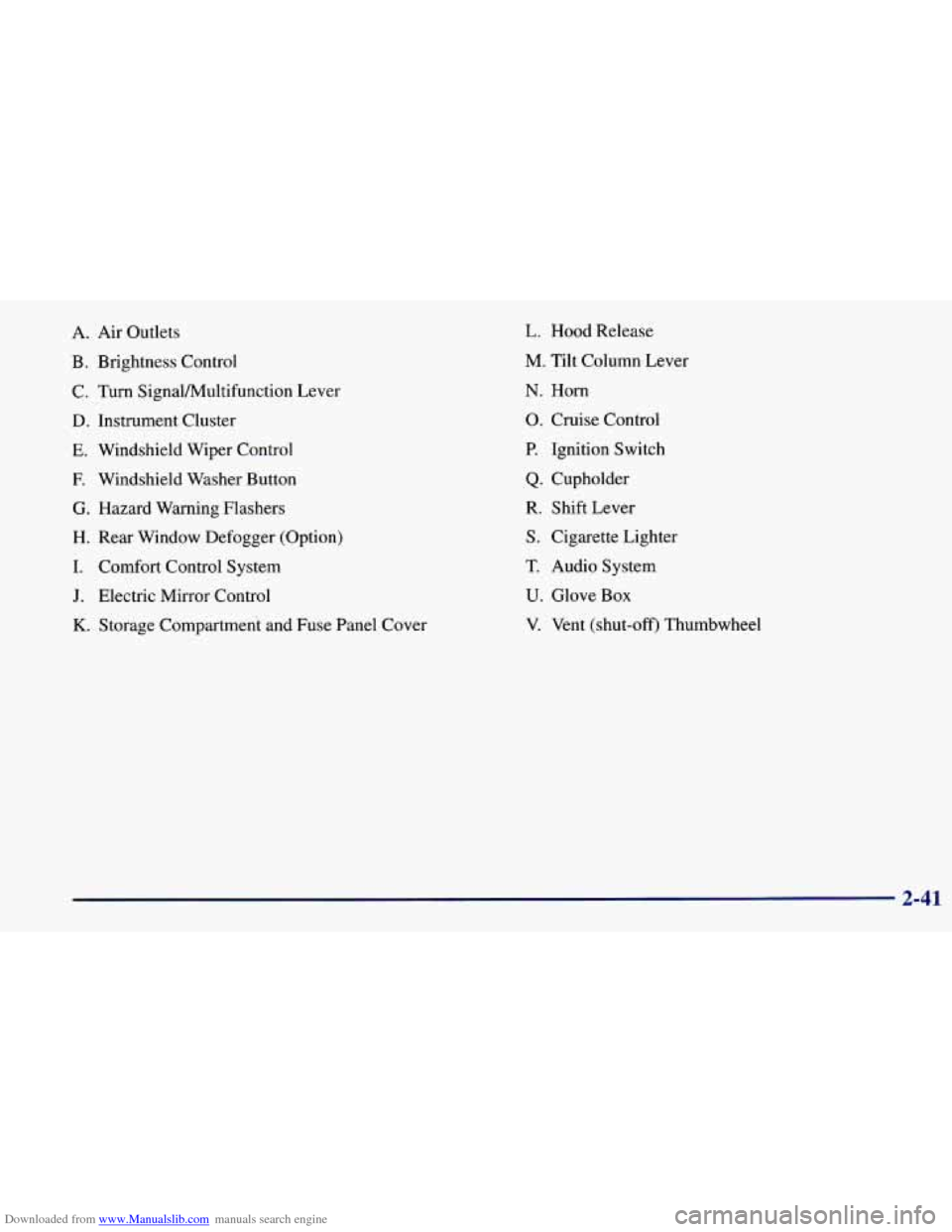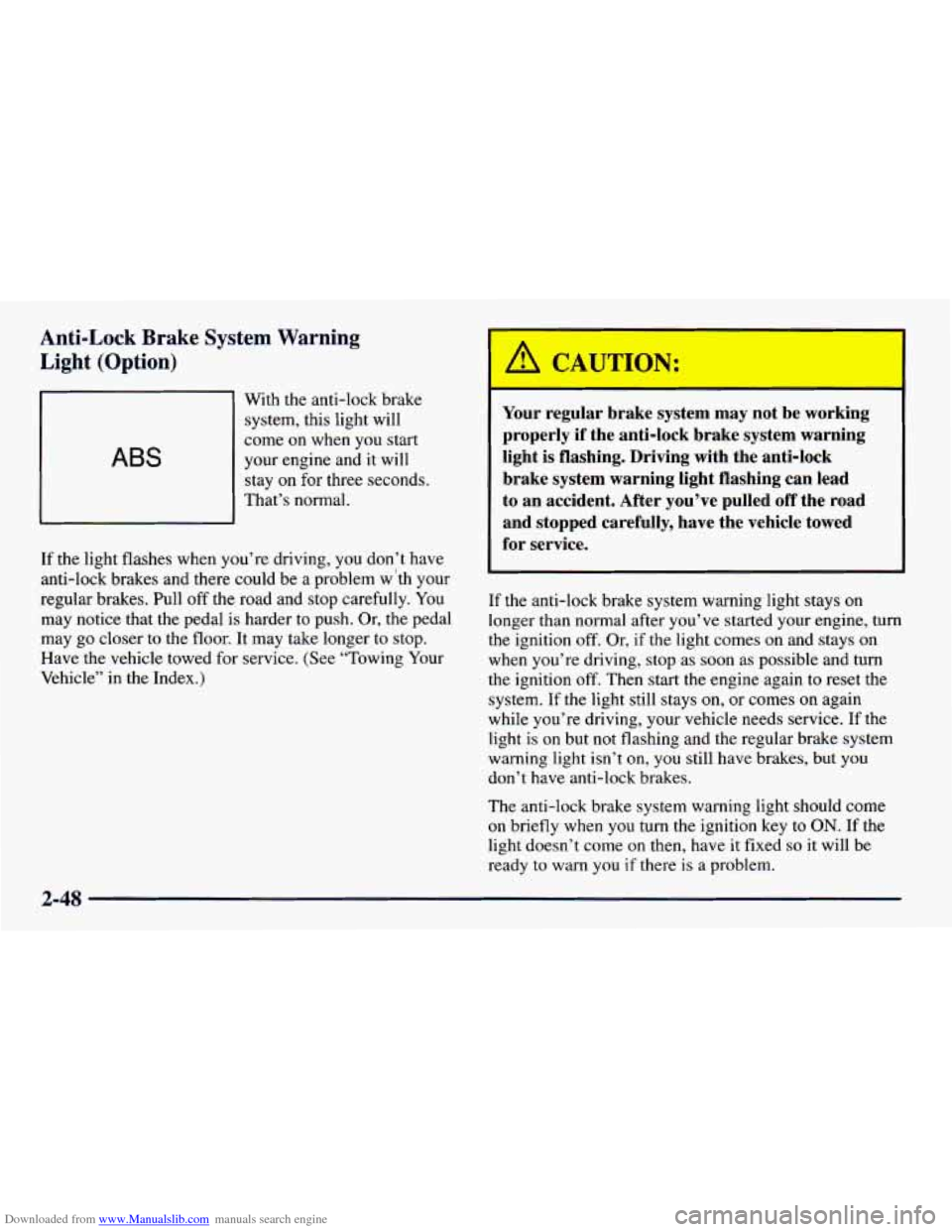1998 CHEVROLET PRIZM warning light
[x] Cancel search: warning lightPage 14 of 364

Downloaded from www.Manualslib.com manuals search engine Vehicle Symbols
These are some of the symbols you may find on your vehicle.
For example,
these symbols
are used
on an
original battery:
POSSIBLE A
CAUTION
INJURY
PROTECT EYES BY
SHIELDING
Q
CAUSTIC
ACID COULD BATTERY
CAUSE
BURNS
AVOID
SPARKS
OR
FLAMES
SPARK
OR ,111,
COULD FLAME
EXPLODE BATTERY
These symbols are important
for you and
your passengers whenever your
vehicle
is
driven:
DOOR LOCK
UNLOCK
FASTEN SEAT
BELTS
These symbols
have to do with
your lamps:
SIGNALS e e
TURN
FOG LAMPS
$0
These symbols are
on some of
your controls:
WINDSHIELD
WIPER
WINDSHIELD DEFROSTER
WINDOW
DEFOGGER
VENTILATING FAN
These symbols are used on
warning and
indicator lights:
ENGINE t
COOLANT t- TEMP -
CHARGING I-1
BATTERY
SYSTEM
BRAKE
(0)
COOLANT a
ENGINE OIL w,
PRESSURE
ANTI-LOCK
(8)
BRAKES
Here are some
other symbols
you may see:
FUSE
LIGHTER
a
HORN )tr
SPEAKER
b
FUEL p3
viii
Page 79 of 364

Downloaded from www.Manualslib.com manuals search engine a Section 2 Features and Controls
Here you can learn about the many standard and optional features on your vehicle, and information on starting,
shifting and braking. Also explained are the instrument panel and the warning systems that tell
you if everything is
working properly -- and what to do if you have a problem.
2-2 2-4
2-6
2-9
2-10 2-1
1
2-1 1
2-13 2- 14
2-18
2-20
2-2 1
2-23
2-24 Keys
Door Locks
Keyless Entry System (If Equipped)
Trunk
Theft
New Vehicle “Break-In”
Ignition Switch
Starting Your Engine
Automatic Transaxle Operation
Manual Transaxle Operation
Parking Brake
Shifting Into Park (P) (Automatic
Transaxle Only) Parking Over Things That Burn
Engine Exhaust 2-24
2-25
2-26
2-26
2-27
2-32
2-34
2-3
5
2-37
2-38
2-3
8
2-39
2-40
2-45 Running
Your Engine While You’re Parked
(Automatic Transaxle)
Windows
Horn
Tilt Column (Option)
Turn Signalhlultifunction Lever
Exterior Lamps
Interior Lamps
Mirrors Storage Compartments
Ashtrays and Lighter
Sun Visors
Sunroof (Option)
Instrument Panel
Warning Lights, Gages and Indicators
2-1
Page 90 of 364

Downloaded from www.Manualslib.com manuals search engine ACC (ACCESSORY) (B): In this position, you can
operate some of your electrical power accessories (such
as the radio, but not the ventilation fan). It unlocks the
steering wheel and ignition.
To move the key from ACC
to LOCK, push in the key and then turn it to LOCK.
ON (C): The switch returns to this position after you
start your engine and release the switch. The switch
stays in the
ON position when the engine is running. But
even when the ignition is not running, you can use ON
to operate your electrical power accessories (including
the ventilation fan) and to display some warning and
indicator lights.
START (D): This position starts the engine. When the
engine starts, release the key. The ignition switch will
return to ON for normal driving.
When the engine is not running,
ACC and ON allow
you to operate some
of your electrical accessories.
A warning tone will sound if you open the driver’s
door when the ignition
is in ACC or LOCK and the
key is in the ignition. On manual transaxle
vehicles, turning the key to
LOCK and removing it will lock the steering
column and result in
a loss of ability to steer the
vehicle. This could cause
a collision. If you need
to turn the engine off while the vehicle is moving,
turn the key only to
ACC. Don’t push the key in
while the vehicle is moving.
NOTICE:
If your key seems stuck in LOCK and you can’t
turn it, be sure you are using the correct key; if
so, is it all the way in? If it is, then turn the
steering wheel left and right while you turn the
key hard. But turn the key only with your hand.
Using
a tool to force it could break the key or the
ignition switch. If none
of this works, then your
vehicle needs service.
2-12
Page 98 of 364

Downloaded from www.Manualslib.com manuals search engine Parking Brake
To set the parking brake, hold the brake pedal down and
pull up
on the parking brake lever. If the ignition is on,
the brake system warning light will
cQme on.
To release the parking brake, hold the brake pedal down.
Pull the parking brake lever up until you can press the
release button. Hold the release button
in as you move
the lever all the way down.
2-20
Page 119 of 364

Downloaded from www.Manualslib.com manuals search engine A. Air Outlets
B. Brightness Control
C.
Turn SignalMultifunction Lever
D. Instrument Cluster
E. Windshield Wiper Control
E Windshield Washer Button
G. Hazard Warning Flashers
H. Rear Window Defogger (Option)
I. Comfort Control System
J. Electric Mirror Control
K. Storage Compartment and Fuse Panel Cover L.
Hood Release
M. Tilt Column Lever
N. Horn
0. Cruise Control
P. Ignition Switch
Q. Cupholder
R. Shift Lever
S. Cigarette Lighter
T. Audio System
U. Glove Box
V. Vent (shut-off) Thumbwheel
2-41
Page 123 of 364

Downloaded from www.Manualslib.com manuals search engine Warning Lights, Gages and Indicators
This part describes the warning lights and gages that
may be on your vehicle. The pictures will help you
locate them.
Warning lights and gages can signal that something is
wrong before it becomes serious enough to cause an
expensive repair or replacement. Paying attention
to
your warning lights and gages could also save you or
others from injury.
Warning lights come on when there may be or is a
problem with one of your vehicle’s functions.
As you
will see in the details on the next few pages, some
warning lights come on briefly when you start the
engine just to let you know they’re working. If you are
familiar with this section, you should
not be alarmed
when this happens.
Gages can indicate when there may be or is
a problem
with one
of your vehicle’s functions. Often gages and
warning lights work together to let you know when
there’s a problem with your vehicle. When
one of the
warning lights comes on and stays
on when you are driving, or when one of the gages
shows there may be a problem, check the section that
tells you what to do about it. Please follow this manual’s
advice. Waiting
to do repairs can be costly -- and even
dangerous.
So please get to know your warning lights
and gages. They’re
a big help.
Safety Belt Reminder Light
When the key is turned to ON or START, a tone will
come on for about eight seconds to remind people to
fasten their safety belts, unless the driver’s safety belt
is already buckled.
The safety belt light
will also flash until the
driver’s belt is buckled.
If the driver’s belt is already buckled, neither the tone
nor the light
will come on.
- 2-45
Page 125 of 364

Downloaded from www.Manualslib.com manuals search engine BRAKE
Brake System Warning Light
Your vehicle’s hydraulic brake system is divided into
two parts.
If one part isn’t working, the other part can
still work and stop you. For good braking, though, you
need both parts working well.
If the warning light comes on, there is a brake problem.
Have your brake system inspected right away.
This light should come
on
when you turn the key to
START.
If it doesn’t come
on then, have it fixed
so it
will be ready to warn you
if there’s a problem.
If the light comes on while you are driving, pull off the
road and stop carefully.
You may notice that the pedal is
harder to push. Or, the pedal may go closer to the floor.
It may take longer to stop. If the light is still on, or if the
anti-lock brake system warning light is flashing, have
the vehicle towed for service, (See “Anti-Lock Brake
System Warning Light” and “Towing Your Vehicle” in
the Index.)
Your brake system may not be working properly
if the brake system warning light is
on. Driving
with the brake system warning light on can lead
to an accident. If the light is still on or if the
anti-lock brake system warning light is flashing
after you’ve pulled
off the road and stopped
carefully, have the vehicle towed for service.
When the ignition is on, the brake system warning light
will also come on when you set your parking brake. The
light will stay on if your parking brake doesn’t release
fully. If it stays on after your parking brake
is fully
released, it means you have a brake problem.
2-47
Page 126 of 364

Downloaded from www.Manualslib.com manuals search engine Anti-Lock Brake System Warning
Light (Option)
ABS
With the anti-lock brake
system, this light will
come
on when you start
your engine and it will
stay on for three seconds.
That’s normal.
If the light flashes when you’re driving, you don’t have
anti-lock brakes and there could be a problem w ‘th your
regular brakes. Pull
off the road and stop carefully. You
may notice that the pedal is harder to push. Or, the pedal
may go closer to the floor. It may take longer to stop.
Have the vehicle towed for service. (See “Towing Your
Vehicle” in the Index.)
Your regular brake system may not be working
properly if the anti-lock brake system warning
light is flashing. Driving with the anti-lock
brake system warning light flashing can lead
to an accident. After you’ve pulled
off the road
and stopped carefully, have the vehicle towed
for service.
If the anti-lock brake system warning light stays on
longer than normal after you’ve started your engine, turn
the ignition
off. Or, if the light comes on and stays on
when you’re driving, stop as soon as possible and turn
the ignition
off. Then start the engine again to reset the
system. If the light still stays
on, or comes on again
while you’re driving, your vehicle needs service. If the
light is
on but not flashing and the regular brake system
warning light isn’t
on, you still have brakes, but you
don’t have anti-lock brakes.
The anti-lock brake system warning light should come
on briefly when you turn the ignition key to ON. If the
light doesn’t come
on then, have it fixed so it will be
ready to warn
you if there is a problem.